Abstract
In order to improve fruit yield, girdling technology is widely used in fruit production. However, in the practice of Hui jujube planting in Southern Xinjiang, it was found that the jujube fruit quality declined and the health problems and death rate of jujube trees increased after jujube trees have been girdled continuously for many years, which seriously affected the economic benefits of jujube planting. So, this study was carried out to explore the specific influence law of continuously jujube-tree girdling for many years on the main nutrients (soluble solid, protein, total acid, vitamin C, total sugar, fat and so on), physical quality attributes (single-fruit weight, hardness and geometric-mean diameter) of jujube fruit and tree health. Through the detection of the nutrients of jujube fruit, it was found that the long-term girdling of jujube trees significantly reduced the main nutrients of jujube fruit. The total sugar and reducing sugar content of jujube-fruit samples from the trees without girdling were 134.23% and 109.62% of the corresponding indexes of jujube-fruit samples from girdled ones, respectively; furthermore, the sugar–acid ratio of jujube samples from the girdled trees was 149.95, while the sugar–acid ratio of fruit from non-girdled trees reached 183.78. Moreover, the protein content of fruit from non-girdled trees was 5.91% higher than that of fruit from girdled ones. In addition, the single-fruit weight, hardness and geometric-average diameter of jujube from non-girdled jujube trees were 20.25%, 13.31% and 20.21% higher than those of jujube from girdled ones, respectively. Moreover, microstructural analysis of the callus and the newly formed phloem showed that the adverse effects of girdling on the phloem function were persistent and permanent. It was also found that jujube-tree girdling can also cause damage, to a certain extent, to the xylem around the girdling wound. The above research results further explained the internal cause of jujube-tree death caused by long-term continuously jujube-tree girdling. The results of this study can provide some scientific basis for the effective application of fruit-tree-girdling technology in fruit production.
1. Introduction
Jujube is rich in nutrients, including extremely high ascorbic acid, a variety of amino acids, dozens of mineral elements, sugars, phenols and other nutrient substances [1,2,3,4,5,6]. Due to its high edibility and medicinal value, it is deeply loved by consumers. China is the birthplace of jujube trees and the main production area for jujube in the world [7]. In China, the jujube-planting area accounts for more than 98% of the total jujube-cultivation area in the world. The jujube-planting area in southern Xinjiang alone is about half a million hectares [8]. Jujube planting has become the pillar of the fruit industry in southern Xinjiang and the main economic source for fruit producers [9].
In order to ensure the high setting rate of flower and fruit, and improve the yield of jujube, most varieties, such as Hui jujube and Winter jujube trees, need to be girdled in the full-bloom stage [10]. Girdling technology is widely used in the process of fruit-tree cultivation, such as jujube [11], apple [12] and grape [13] planting, and so on, because it is a simple and efficient method for increasing the yield for a fruit tree. Girdling refers to peeling off a circle of the bark from the phloem to the epidermis with a knife, without harming the xylem on the trunk or branch of the fruit tree, temporarily cutting off the downward transportation of nutrients in the tree, so as to meet the nutrient needs of flowering and fruit setting, thereby promoting fruit setting. When the branch is selected for girdling, the girdling wounds’ width is generally 10~20 mm; if the trunk is girdled, the girdling wound’s width is about one-tenth of the trunk diameter. The girdling width of branches is generally greater than that of trunk, for the healing ability of branches is usually greater than that of trunk. The advantages of branch girdling are that the girdling wounds have a fast-healing ability and it causes little damage to the tree. Generally, small trees or weak trees adopt branch girdling [14], while strong trees generally adopt trunk girdling [15]; trunk girdling usually begins to girdle for the first time at 30 cm on the trunk above the ground, and the new girdling each year is usually performed above the previous ones.
Fruit farmers in Southern Xinjiang generally choose to girdle the trunk of jujube trees, because this girdling scheme has more advantages for them. First of all, trunk girdling has an obvious effect on increasing production and income, which can usually increase production by 30~50% compared with jujube trees without girdling (according to the statistics of fruit farmers), and the labor cost is also significantly reduced compared with branch girdling. Secondly, according to our investigation and the statement of fruit farmers, a large number of tender phloem is exposed after the girdling of branches, which is easy to cause insects to bite the phloem or lay eggs on the wounds caused by girdling, causing adverse effects on the health of jujube trees. However, after trunk girdling, there is only one girdling wound, and the phloem on the wound has low moisture content and high hardness, so it is not easy to cause the above problems. Therefore, jujube farmers in southern Xinjiang generally choose trunk girdling. In order to increase jujube yield and fruit producers’ income, fruit farmers often girdle jujube trees every year [16].
However, according to our observation and statistics with jujube growers, long-term continuous girdling has significant adverse effects on jujube-fruit quality and tree health. Firstly, the sweetness of the jujube fruit produced by long-term continuously girdled jujube trees decreases and the taste becomes bad; secondly, the overall volume of a single jujube fruit is reduced. In addition, after years of continuous girdling of jujube trees, not only the yield of jujube fruits has been reduced, but also many other problems have occurred, such as the increase in dead trees and the difficult healing of girdling wounds, which greatly affect the healthy and sustainable development of jujube-tree planting and have a negative impact on the economic benefits of jujube fruit.
At present, domestic and foreign scholars’ research on the girdling of fruit trees mainly focuses on the impact of fruit-tree-girdling treatment on the yield and nutrient content of fruit, as well as its impact on the short-term physiological growth of fruit trees in the early stage of fruit-tree planting. Research showed that different girdling stages at the flowering stage had certain effects on fruit setting rate, yield and quality of winter jujube, and girdling could promote the accumulation of sugar in jujube as a whole [17]. Scholars also studied the influence mechanism of girdling on mango growth [18]. In addition, a study also showed that girdling had an important effect on the yield and quality of cherry [19,20]. Chen, J.Y. found that the application of girdling technology had significant impact on the fruit characteristics of Red Globe grape [21]. Anthocyanin content in Hong yang kiwifruit was also affected by girdling [22]. In addition, a study found that different girdling dates had an effect on tree growth, fruit characteristics and reserve accumulation in a late-maturing persimmon [23]. However, at present, the relevant literature about the adverse effects of long-term continuous fruit-tree girdling on jujube-fruit quality and jujube-tree health was not found yet. Therefore, in order to explore the specific impact of years of girdling treatment on the jujube-fruit quality and the trees’ health, this study was carried out to do some relevant experimental research, so as to provide some help for guiding the girdling technology’s scientific and reasonable implementation in jujube-tree planting and promote the healthy development of the jujube industry.
2. Materials and Methods
2.1. Materials
In order to study the specific impact of long-term continuous girdling of jujube tree on the quality of jujube, 10 Hui jujube trees which were not girdled in the jujube garden were chosen as the control group (this jujube garden is our experimental plot, all jujube trees are the same age, and only a small number of jujube trees were never girdled). One kg jujube fruit was randomly collected from each jujube tree in the control group to form 10 jujube-fruit samples of non-girdled jujube trees; then, other 10 jujube-fruit samples from girdled jujube trees were collected by the same method. In addition, these samples were picked when jujube was in full maturity stage in the experimental plot, on 25 September 2021, in Alar, southern Xinjiang, China. Besides, in order to study the healing process of the girdling wound, the callus from the place of girdling wound was collected 45 days and 150 days after girdling, respectively, in the same experimental field. When collecting callus samples, ten jujube trees with complete callus bridge were selected, and each time the callus was cut from the girdling wound of these trees. In addition, the length of each callus cut from trees was 10 mm, the width was the size of the girdling wound (about 6~10 mm), and the thickness was the thickness of the complete callus. The jujube garden status and some experimental materials are shown in Figure 1. The tree age is 8 years, and the jujube trees were girdled every year. The plant spacing of jujube trees is about 1.5 m, and the row spacing is 4 m.
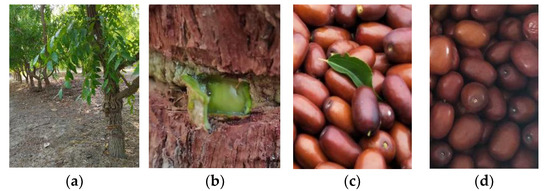
Figure 1.
Jujube garden status and main materials used in the experiment: (a) the condition of jujube garden; (b) callus formed after 45 days of girdling; (c) mature jujube fruit from the jujube trees without girdling; (d) mature jujube fruit from the girdled jujube trees.
2.2. Test Indicators of Jujube-Fruit Quality
The jujube samples above were used to test the nutrients and its physical characteristics of jujube fruit from the girdled and non-girdled jujube trees. The internal quality indexes of jujube fruit that were tested included the contents of soluble solid, water, total acid, protein, vitamin C, fat, total sugar and reducing sugar. While the physical quality indexes of jujube fruit tested in this study included single-fruit weight, hardness and geometric-average diameter.
2.2.1. Test Methods for Physical Quality of Jujube Fruit
The single-fruit weight was obtained by dividing the sample weight by the number of jujubes contained in the sample. The whole-fruit puncture test was used to determine the hardness of jujube samples collected from girdled and non-girdled trees. In the experiment, 30 fruits were taken from each sample for hardness measurement, and the average value of the 30 fruits’ hardness was taken as the final value for this sample. The measuring instrument was GY-4 digital display hardness tester produced by Leqing Aidebao Instrument Co., Ltd. (Leqing, China) with a resolution of 0.01 kgf/cm2. The diameter of puncture head was 2 mm and the puncture depth was 3 mm. During the measurement, the jujube fruit was fixed, the lifting handle was manually rotated at a uniform speed until the probe of the durometer pierced about 3 mm below the peel and then the data were recorded. The hardness-measuring part was near the equator of the fruit. Then, each jujube fruit was measured 4 times around the equator in total, and their average value was taken as the final result of this jujube. The hardness-test method of jujube is shown in Figure 2, and the hardness value is calculated by Equation (1).
where N is the hardness of jujube, kgf/cm2; Fmax is the maximum force applied on jujube, N; S is the cross-sectional area of the indenter, cm2.
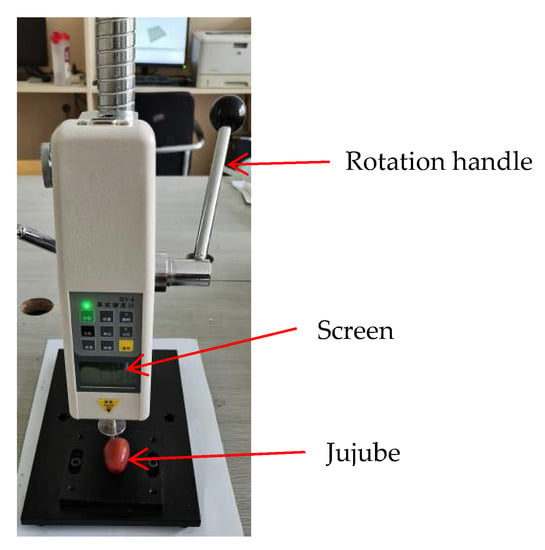
Figure 2.
Jujube-hardness test.
The jujube geometric-mean diameter was calculated by Equation (2).
where Dg is the geometric-mean diameter, mm; L is the length, mm; W is the width, mm; and T is the thickness, mm.
In addition, the flesh from different jujube-fruit samples was observed by APREO-S scanning-electron microscope (SEM) produced by Thermo Fisher Scientific (Waltham, MA, USA) and optical microscope. When observing the jujube fruit by scanning-electron microscope, 20 jujube fruits were randomly taken from each sample and cut from each jujube fruit with a length, width and thickness of 0.5 cm × 0.5 cm × 0.3 cm square, to make observation samples. The samples were then rinsed twice with 0.1 mol/L phosphoric acid buffer to remove impurities, and then fixed with 2.5% glutaraldehyde for 5 h. The samples were then dehydrated by a gradient, followed by critical-point drying using a critical-point dryer. After critical-point drying and sputter coating with ion sputter, the samples were finally put into the SEM for observation.
2.2.2. Detection Methods of the Main Nutrients of Jujube
The crude-protein content was determined by Kjeldahl method. In the experiment of protein determination, the core of jujube was removed, jujube flesh was ground into powder after drying. The powder sample was taken at 0.300 g and poured into a dry digestive tube, and shaken well after 0.2 g copper sulfate and 6 g potassium sulfate was added, then 20 mL of concentrated sulfuric acid was added. It was heated at a low temperature until all the contents were carbonized, and the foam in the digestive tube stopped; it was then heated at a low temperature to keep slightly boiling until the liquid was blue-green and clear; it was then continued to heat up for 30 min before cooling; at last, it was added with water to volume up to 100 mL, that was, the digestive liquid of sample. According to the above method, copper sulfate, potassium sulfate, and concentrated sulfuric acid of the same amount as the sample used for digestion was taken for digestion; after cooling, it was diluted to 100 mL, that was, the blank digestive solution. In total, 10 mL of sample digestion solution was taken in the digestive tube, put into Kjeldahl nitrogen determinator for distillation for 7 min, then the liquid was titrated. At the same time, the 10.0 mL blank digestion solution was distilled according to the upper method. All determinations were performed in triplicate. The protein content was calculated by Equation (3).
where Y is mass fraction of protein, %; c is concentration of hydrochloric acid standard solution, mol/L; V0 is the volume of standard solution consumed in blank titration, mL; V1 is the volume of standard solution consumed in sample titration, mL; 14 is the millimolar mass of nitrogen, g/mmol; F is the conversion coefficient of nitrogen to protein, 6.25; and m is sample weight, g.
Then, the crude fat content was determined by Soxhlet extraction method [24]. The national standard GB/T 5009.7-2008 was referenced to measure the total sugar content. In addition, the content of soluble solids was determined by handheld refractometer [25]. During the soluble-solids measurement, 15 jujubes were selected from each sample, their juice was extracted by juicer. The juice was filtered by three layers of gauze, and an appropriate amount of fruit juice was taken to determine the content of soluble solids by handheld refractometer LH-B55 (Luheng Environmental Technology Cable Co., Ltd., Shanghai, China). The content of vitamin C was determined by 2, 6-dichloroindophenol titration [26]. Total acid content was determined by the acid–base-titration method [27]. The content of reducing sugar was determined by ferin colorimetry. The moisture content of jujube was determined by normal atmospheric temperature and constant pressure drying method. The moisture content test samples of jujube were cut into 3 mm thick slices, then were dried in an oven at 105 °C to a constant mass. Then, the moisture content was measured by Equation (4).
where M is the moisture content of jujube, %; W1 is the weight of jujube before drying, g; and W0 is the weight of jujube after drying, g.
2.3. Comprehensive Evaluation of Jujube-Fruit Quality
In order to evaluate the effects of girdling on the quality of jujube fruit, the indexes of internal quality of jujube from non-girdled and girdled jujube trees were comprehensively evaluated by radar map method.
Some jujube fruit quality indicators are positive ones (i.e., the larger the better), while some are negative ones (i.e., the smaller the better), so we cannot directly conduct comprehensive evaluation on these indicators. Therefore, for the convenience of analysis, all the indexes of internal quality of jujube were normalized, and their dimension was unified as “1”. Thus, all positive indicators were processed in this way: the larger value of each index measured corresponding to the girdled jujube fruit, and non-girdled jujube fruit was divided by the smaller value; then, the larger index data were replaced with this ratio, while the smaller were replaced with “1”. The treatment method of inverse index (such as total acid, moisture content, etc.) was opposite to that of positive index. After the experimental data were processed in this way, it was ensured that the larger the indexes in the radar map, the better; and the larger the area surrounded by the index values of the girdled jujube fruit or the non-girdled jujube fruit, the better the quality of the corresponding jujube.
2.4. Research Methods on the Influence of Long-Term Girdling of Jujube on Tree Growth
Firstly, the healing process of jujube-tree girdling wound was studied. Forty-five days after the girdling of jujube, the callus from the girdling wound was collected and observed by scanning-electron microscope and optical microscope. After 150 days of jujube girdling, the newly formed phloem of girdling wound was collected and observed by SEM and optical microscope again, to analyze the healing process of girdling wound and its effect on jujube health. The methods of making sample sections for the observation of callus and phloem newly formed on the girdling wound by SEM were the same as that of making sample sections of jujube fruit. Furthermore, the changes of the time needed for callus formation of girdling wounds with the long-term girdling times was counted. We stipulated that the time taken when 90% of the callus bridges of wounds were formed was the callus-formation time, and the unit of time was days. A 5-point sampling method was chosen to randomly select 50 healthy girdled jujube trees every time after girdling, the healing condition of girdling wound was observed every 5 days, and the time required for annual girdling wound healing was counted. In addition, the changes of girdling-wound-healing rate in different years of long-term girdling were statistically analyzed; here, healing rate means that the number of jujube girdling-wounds healed (new phloem formed around the girdling wound, that is, wounds healed) in that year accounted for the proportion of total girdling wounds. The statistics of the girdling-wound-healing rate was carried out after the annual jujube harvest, because, since then, the unhealed-girdling wound would no longer heal. In addition, the jujube trees’ mortality (the ratio of the number of dead trees to the total number of trees in that year) was also counted. We have made statistics on these three indicators (callus formation time, girdling-wound-healing rate and jujube-tree mortality) every year since the early stage of jujube planting, to analyze the effects of long-term girdling on jujube trees.
2.5. Statistical Analysis
Microsoft Excel 2007 was used to make tables of the data of jujube physical quality, as well as to calculate the mean and standard deviation of the data. In addition, it was also used for drawing the radar map. The analysis plots of nutrient content of jujube were prepared using Origin 2016 (Origin Lab Corporation, Northampton, MA, USA). Besides, in order to judge the significance of the effect of girdling on the different nutrient indexes’ content of jujube, one-way ANOVA was analyzed for all the measured nutrients, and the relevant results of significance and error bar were marked in the bar chart. Moreover, to study the correlation of multiannual girdling and tree-health indicators, the regression analysis of callus-formation time, girdling-wound-healing rate and jujube-tree mortality, the factor of jujube girdling time was performed separately using Origin 2016.
3. Results
3.1. Effects of Long-Term Continuous Girdling of Jujube Trees on Fruit Quality
3.1.1. Effects of Long-Term Continuous Girdling on Physical Quality of Fruit
The measurement data of single-fruit weight, hardness and geometric-mean diameter of jujube fruit from girdled jujube trees and non-girdled ones with the mean value and standard deviation of each index are shown in Table 1. It can be seen from the results that the single-fruit weight, hardness and geometric-average diameter of the jujube fruit from the non-girdled jujube trees were greater than the corresponding index values of the jujube fruit from the girdled jujube trees. In addition, the single-fruit weight, hardness and geometric-average diameter of jujube from non-girdled jujube trees were 20.25%, 13.31% and 20.21% higher than those of jujube from girdled ones, respectively.

Table 1.
Physical-quality-measurement results of jujube-fruit samples.
Figure 3a,b were, respectively, the images of jujube fruit from non-girdled jujube trees and girdled ones in the light microscope. From Figure 3a,b, it can be seen that there are a number of larger porous structures in the pulp of the jujube fruit from girdled jujube trees, compared with the ones from non-girdled jujube fruit. What we can see from the pulp cells of jujube fruit in the SEM images (Figure 3c) is that the size and shape of cells in jujube from girdled jujube trees are prominently not uniform, while the size and shape of cells in jujube from non-girdled jujube trees are relatively consistent. In addition, through the measurement of the size of pulp cells of jujube fruit from different samples, the results showed that the mean size of jujube cells in the fruit from non-girdled trees are 107.61% of that in the fruit from girdled ones.
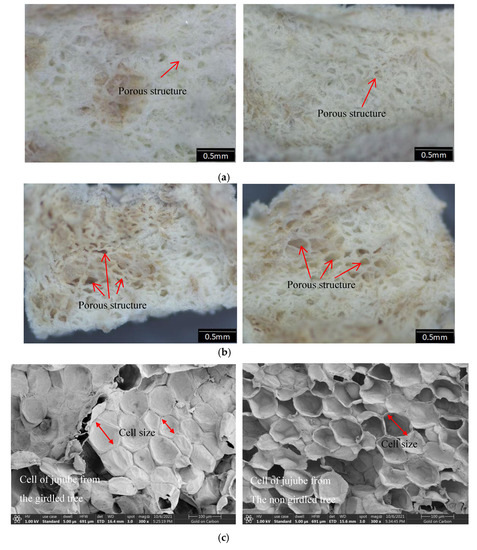
Figure 3.
Microscopic-observation results of the internal structure of jujube fruit: (a) the micrograph of jujube fruit from non-girdled trees; (b) the micrograph of jujube fruit from girdled trees; (c) the microstructure of jujube fruit from the girdled and non-girdled trees in scanning-electron-microscope images.
3.1.2. Effects of Long-Term Girdling on the Nutrient Content of Jujube Fruit
The test results of the content of nutrients in jujube fruit from non-girdled jujube trees and girdled ones are shown in Figure 4. In addition, we made a significance analysis on the content differences of every same nutrient in jujube from girdled jujube trees and non-girdled ones; the results were marked in Figure 4. The conclusions were obtained from Figure 4a,b that the soluble solids and water content of jujube fruit from non-girdled jujube trees were higher than those of girdled ones, with highly significant differences. The conclusion was drawn from Figure 4c,d that the total acid and protein content of jujube fruit from non-girdled jujube trees were higher than those of girdled ones, with significant differences. However, from Figure 4e,f, the information acquired was that the vitamin C and fat content from non-girdled jujube trees were lower than those of girdled ones, with highly significant differences. Furthermore, from Figure 4g,h, it was found that total sugar and reducing sugar content from non-girdled jujube trees were both higher than those of girdled ones, with highly significant differences.
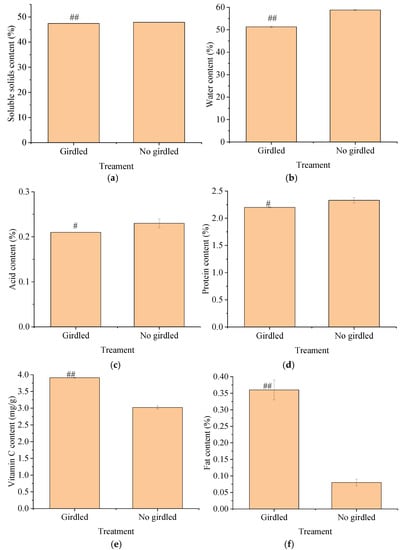
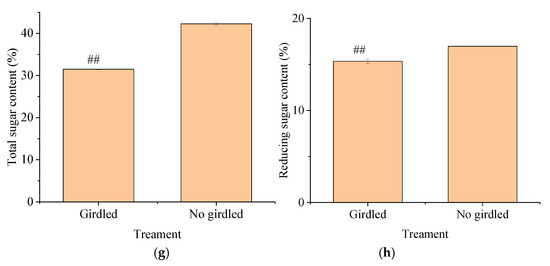
Figure 4.
Comparison of nutrient determination results of jujube-fruit samples: (a) comparison of soluble solid content; (b) comparison of water content; (c) comparison of total acid content; (d) comparison of protein content; (e) comparison of vitamin C content; (f) comparison of fat content; (g) comparison of total sugar content; (h) comparison of reducing sugar content; # represents a significant difference (p values ≤ 0.05), ## represents a highly significant difference (p values ≤ 0.01).
3.1.3. Comprehensive Evaluation of Jujube-Fruit Quality from Different Samples
Figure 5 showed the comprehensive evaluation results of the quality of jujube-fruit samples from non-girdled jujube trees and girdled ones, based on a radar map. It can be seen from the figure that the total sugar, reducing sugar, single-fruit weight and geometric-average diameter of the jujube fruit from non-girdled jujube trees were significantly greater than that of the fruit from girdled ones, and the area enclosed by all the indexes of the jujube fruit from non-girdled trees was also greater than that of the fruit from girdled ones. Therefore, the overall quality of the fruit from non-girdled trees was higher than that of girdled ones. However, the jujube-fruit samples from girdled trees contained more vitamin C, lower water and acid, and these nutritional indicators were better than those of jujube fruit from non-girdled jujube trees.
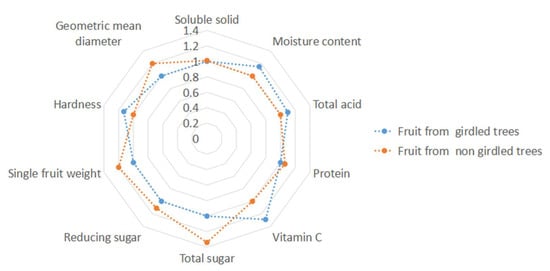
Figure 5.
Comprehensive evaluation on the quality of jujube fruit from different samples.
3.2. Effects of Long-Term Continuous Girdling on Tree Growth
3.2.1. Effects of Long-Term Continuous Girdling on Girdling Wound Healing Speed and Quality
Through years of investigation and statistics on the healing condition of the girdling wounds, the results showed that long-term continuous girdling led to a significant decline in the healing speed and quality of the wounds caused by girdling. In addition, the statistics of the relationship between the time required for the healing of the girdling wounds, the complete healing rate of wounds, the mortality of jujube trees and the long-term continuous girdling time are shown in Figure 6.
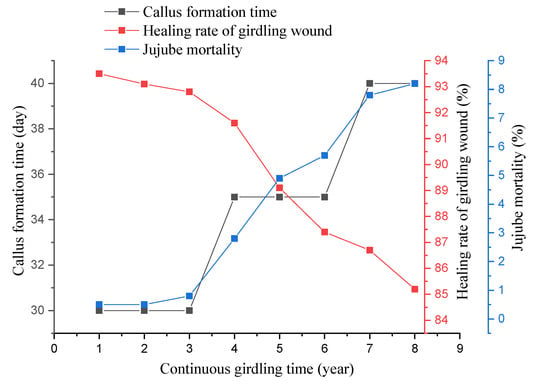
Figure 6.
Effects of long-term continuous girdling on girdling-wound healing and tree death.
The linear-regression-fitting functions between the time required for the healing of girdling wounds, the complete healing rate and the mortality rate of trees and long-term continuous girdling time are shown in Equation (5), respectively. In addition, each of their determination coefficient (R12, R22 and R32) was equal or greater than 0.87. There were significant linear-positive correlations between the time required for the healing of girdling wounds and tree mortality and long-term continuous girdling time, while there was a significant linear-negative correlation between the rate of complete healing of girdling wounds and long-term continuous girdling time.
where x is the girdling time, year; y1 is the time required for the healing of girdling wounds, day; y2 is the healing rate of girdling wounds, %; y3 is the jujube tree mortality, %; and R12, R22 and R32 are the determination coefficients of equations y1, y2 and y3, respectively.
Furthermore, some of the research pictures concerning the effects of long-term continuous girdling on the healing of wounds are shown in Figure 7. Generally, in the early stage of jujube planting (the first three years), about 30 days after jujube girdling, 80% of the girdling wounds can be completely covered by callus, while the remaining 20% of jujube girdling wounds, so only about 10% to 30% of the xylem, was not covered by callus. In addition, about 40 days after jujube girdling, 93.5% of the girdling wounds would heal normally. However, after continuous girdling for many years (more than 6 years), it took about 45 days for 80% of the girdling wounds to form callus completely. At this time, the remaining 20% of the girdling wounds’ surface still had extensive area without callus, as shown in Figure 7a. Moreover, about 15% of the girdling wounds would never fully heal, as shown in Figure 7b. In addition, through the investigation results of dead trees, it was found that about 70% of dead trees had multiple girdling wounds that did not heal normally, as shown in Figure 7c.
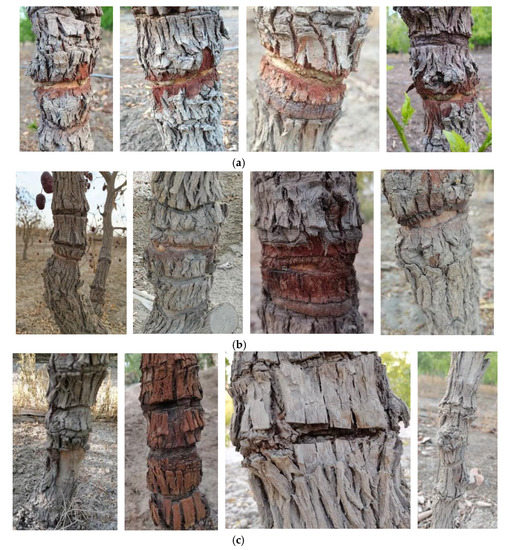
Figure 7.
Effects of long-term continuous girdling on the healing of wounds: (a) incomplete healing of the wounds after 45 days of girdling; (b) unsuccessful healing of girdling wounds; (c) dead trees with multiple girdling wounds.
3.2.2. Effects of Long-Term Continuous Girdling on the Phloem and Xylem
The SEM images of the callus section after 45 days of girdling are shown in Figure 8a, which clearly showed that the callus cells were disordered and undifferentiated at this time. Although the callus of girdling wounds had been formed after 45 days of girdling, the functional structure, such as the vascular tissue, had not been formed. Therefore, during this period, jujube trees still could not carry out the normal transport of nutrients to the roots. SEM images of phloem sections from girdling wounds after 150 days are shown in Figure 8b, so it is clear that there were a large number of unconnected fibers and gaps in the newly formed phloem.
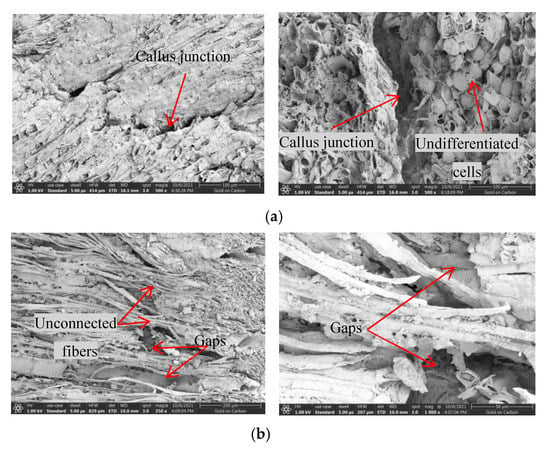
Figure 8.
SEM images of callus and new phloem from girdling wounds: (a) SEM images of callus from girdling wounds after 45 days; (b) SEM images of phloem from girdling wounds after 150 days.
In addition, jujube girdling also caused damage to the xylem. Through the observation of the xylem from the girdling wounds, it was found that there were obvious wounds on the surface of the xylem at some xylem samples, and the color of the xylem became black, as shown in Figure 9a. Furthermore, through the observation of the cross-sectional microscope images of the xylem from the trunk of girdled and non-girdled jujube trees, it was found that the cross-sectional color of the trunk from non-girdled jujube trees was light green (as shown in Figure 9b), but the color of the trunk from some girdled jujube trees turned gray (as shown in Figure 9c).
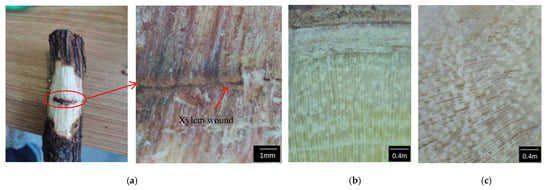
Figure 9.
Jujube girdling caused damage to xylem: (a) girdling caused xylem injury; (b) normal color of cross section of trunk from jujube tree without girdling; (c) the abnormal color of the cross section of the partially trunks from girdled jujube trees.
4. Discussion
4.1. Effects of Long-Term Girdling of Jujube Trees on Jujube-Fruit Quality
The proper use of girdling technology in the process of jujube planting is an important means to improve the yield and quality of jujube fruit. However, the results of this study showed that after continuous girdling for many years, the quality of jujube fruit not only did not improve, but also decreased to a certain extent. The test results showed that the weight, hardness and geometric-mean diameter of jujube fruit from non-girdled jujube trees were significantly greater than the corresponding index value of girdled jujube trees, which was quite different from the general conclusions, such as that girdling can increase the weight of a single fruit, and so on [28,29]. What is more, the observation results of microscope and scanning-electron-microscope images showed that there were a large number of big porous structures in the pulp of the girdled jujube fruit compared with the non-girdled jujube fruit. Therefore, the physical quality of jujube fruit from girdled jujube trees was lower than that of the fruit from non-girdled ones to a certain extent.
The results of a nutrient test of jujube fruit showed that the overall quality of jujube-fruit samples without girdling was also higher than that of girdled jujube fruit. Among them, the sugar content is an important index to measure the quality of jujube fruit. The total sugar and reducing-sugar content of jujube-fruit samples from the trees without girdling were 134.23% and 109.62% of the corresponding indexes of jujube-fruit samples from girdled ones, respectively. Furthermore, the sugar–acid ratio of jujube samples from the girdled trees was 149.95, while that of fruit from non-girdled trees reached 183.78. This was clearly different with the previous research result that proper girdling could significantly improve the sugar content of fruit [29,30,31]. Moreover, the protein content of fruit from non-girdled trees was 5.91% higher than that of fruit from girdled ones. So, long-term continuous girdling of jujube tree had adverse effects on the nutrient content of jujube fruit.
4.2. Effects of Long-Term Continuous Girdling on Jujube Trees
Through the investigation and statistical analysis of the healing of girdling wounds, the results showed that long-term continuous girdling led to a significant decline in the healing speed and quality of jujube girdling wounds. The study found that about 70% of the dead trees had multiple girdled wounds that did not heal normally, and the mortality of jujube trees increased significantly with many years of girdling. This indicated that long-term continuously girdled jujube trees were prone to tree death, which was similar to the conclusion of Fallahi, E. et al. [12]. Then, 45 days after the jujube trees were girdled, SEM images observation of the callus sections showed that the callus had not differentiated to form functional structures, such as the sieve tube and phloem fiber, so could not transport nutrients to roots normally yet. Next, 150 days after the jujube trees were girdled, the functional structures and tissues of the phloem from girdling wounds completely formed, but there were a large number of unconnected fibers and voids in the new formed phloem, which would inevitably have an adverse impact on the normal transportation of nutrients in the phloem.
Long-term continuous girdling caused damage to the xylem and made adverse effects on jujube health. Through the observation of the xylem from the healed girdling wounds, it was found that there were obvious black-wound rings on the surface of some xylem, indicating that girdling could cause mechanical damage to the xylem. Observation of the cross-sectional microscope images of the xylem showed that the cross-sectional color of the trunk from non-girdled jujube trees was light green, but the color of some trunks from girdled jujube trees became gray. This possibly was due to the fact that the photosynthetic products could not be normally transported to the roots of jujube trees because of girdling, so the roots of jujube trees could not get enough nutrition for a long time, which weakened the physiological activity of the roots [32]; moreover, the roots did not properly supply enough water to the trees through the xylem [33,34,35], so eventually the xylem moisture was insufficient and its color changed. Girdling could significantly reduce the content of various sugars and other nutrients in the root system [23], and the continuous lack of nutrient supply to the roots also hindered the normal and efficient photosynthesis of jujube leaves [35,36]; this may be the reason for the significant decline of jujube-fruit quality after continuous girdling for many years.
In this study, only the nutrients of jujube fruits from the trees that had been continuously girdled for more than 7 years were measured and compared with that from non-girdled trees in the same year. However, it is still unclear whether the physiology of jujube trees will be significantly affected and the quality of jujube fruits will decline after a certain number of years of continuous girdling. Therefore, in the future research, more systematic and comprehensive research work about girdling can be carried out, which will be of great significance to the scientific cultivation of jujube and even other fruit trees.
5. Conclusions
This study found that continuous girdling of jujube trees for many years had significant adverse effects on fruit quality and tree health. First of all, the continuous girdling of jujube trees for many years led to the reduction in total sugar, reducing sugar content, single-fruit weight and size, etc., resulting in the decline of jujube-fruit quality. Secondly, long-term jujube girdling reduced the rate of callus formation and the normal healing rate of girdling wounds. The continuous girdling of jujube trees for many years led to serious damage to the phloem, making its nutrient transport capacity to the roots worse and worse, which reduced the physiological activity and increased the mortality of the tree. With these results, to some extent, we have contributed to the knowledge on how continuous girdling of jujube trees for many years affected fruit quality and tree health. The research results can provide some basic guidance for the correct application and development of girdling technology in the fruit-planting industry.
Author Contributions
Resources, X.W.; data curation, C.H.; writing—original draft preparation, J.R. and W.G.; writing—review and editing, C.H. and P.L.; visualization, C.H.; supervision, X.W.; project administration, X.W. and P.L. All authors have read and agreed to the published version of the manuscript.
Funding
This work was supported by the Scientific and Technological Planning Projects of First Division Alar City, Xinjiang Construction Corps, grant number 2022ZB03; the Innovative Research Project of the Tarim University President Foundation, grant number TDZKSS202112; and the Innovative Research Project of the Tarim University President Foundation, grant number TDZKCX202103.
Institutional Review Board Statement
Not applicable.
Informed Consent Statement
Not applicable.
Data Availability Statement
The data presented in this study are available on request from the corresponding author.
Acknowledgments
We are grateful for the support of “Xinjiang Uygur Autonomous Region Forestry and Fruit Industry to Improve Quality and Efficiency of Special Project: landing red dates efficient pick up harvester development”, and we would like to thank Professor Yunfeng Pu for his guidance in the experiment.
Conflicts of Interest
The authors declare no conflict of interest.
References
- Yuan, H.; Wang, J.L.; Yuan, H. Quality evaluation of Xinjiang jujube based on principal component analysis and cluster analysis. Food Ind. 2020, 41, 305–309. [Google Scholar]
- He, W.Z.; Zhao, D.Y.; Fan, Y.Y.; Wang, C.; Liu, Z. Comparison of the Nutrient Quality, Stable Isotope and Multi-Element Characteristics of Xinjiang Jujube for Origin Traceability. J. Nucl. Agric. Sci. 2021, 35, 1099–1112. [Google Scholar]
- Zhao, A.L.; Xue, X.F.; Ren, H.Y.; Wang, Y.K.; Ling, D.K.; Ling, Y. Analysis of composition and content characteristics of organic acids in Jujube germplasm. Acta Agric. Boreali-Occident. Sin. 2021, 30, 1185–1198. [Google Scholar]
- Chen, C.F.; Lee, J.F.; Wang, D.; Shen, C.Y.; Shen, K.L. Water extract of Zizyphus jujube attenuates ischemia/reperfusion-induced liver injury in rats. Transplant. Proceeding 2010, 42, 741–743. [Google Scholar] [CrossRef]
- Li, J.W.; Ding, S.D.; Ding, X.L. Comparison of antioxidant capacities of extracts from five cultivars of Chinese jujube. Process Biochem. 2005, 40, 3607–3613. [Google Scholar] [CrossRef]
- Shen, X.; Tang, Y.; Yang, R.; Yu, L.; Fang, T.H.; Duan, J.A. The protective effect of Zizyphus jujube fruit on carbon tetrachloride-induced hepatic injury in mice by anti-oxidative activities. J. Ethnopharmacol. 2009, 122, 555–560. [Google Scholar] [CrossRef]
- Song, Y.; Wang, J.Z. Evaluation of Sensory and Physico-Chemical Properties of Grey Jujube from Different Producing Regions. Mod. Food Sci. Technol. 2021, 37, 148–154. [Google Scholar]
- Guan, Q.L. Study on the Potential and Strategy to Develop Jujube in Xinjiang Province. Master’s Thesis, Huazhong Agricultural University, Wuhan, China, 2010. [Google Scholar]
- Liu, C. Studies on Functional Components and Processing Technology of Xinjiang Jujube Dates. Master’s Thesis, Zhejiang University, Hangzhou, China, 2014. [Google Scholar]
- Xu, H.B.; Feng, J.C.; Fan, L.L. Research progress on girdling mechanism and non-invasive girdling technology of pomiculture. J. Henan Agric. Sci. 2020, 49, 1–9. [Google Scholar]
- Shi, H.; He, X.E.; Ding, R.H. Effects of different girdling periods on photosynthesis of southern Winter jujube. J. Anhui Agric. Sci. 2021, 49, 48–51. [Google Scholar]
- Fallahi, E.; Kiester, M.J.; Fallahi, B.; Mahdavi, S. Rootstock, canopy architecture, bark girdling, and scoring influence on growth, productivity, and fruit quality at harvest in ‘Aztec Fuji’ apple. Hortscience 2018, 53, 1629–1633. [Google Scholar] [CrossRef] [Green Version]
- Han, S.A.; Liao, K.; Pan, M.Q.; Zhong, H.X.; Zhang, F.C.; Zhou, X.M.; Zhang, W.; Xie, H.; Wang, X.Y. Analysis of soluble sugar composition and content of crimson grape cultivars with the trunk girdling. Xinjiang Agric. Sci. 2018, 55, 2021–2027. [Google Scholar]
- Guo, L.; Wang, T.; Yue, L.X.; Fang, J.G.; Chen, J.L.; Song, C.N.; Len, X.P. Influence of main-branch-girdling on berry coloring and expression of some related genes in Fujiminori grapevine. Acta Hortic. Sin. 2012, 39, 409–416. [Google Scholar]
- Zhang, Y.F.; Ren, Z.; Han, L.; Liu, J.N.; Niu, Y.F.; Xu, X.G.; Zhang, Y.; Bai, L. Effects of trunk girdling on quality and formation of grape berry. South China Fruits 2013, 42, 22–26. [Google Scholar]
- Khandaker, M.M.; Hossain, A.S.; Osman, N. Application of girdling for improved fruit retention, yield and fruit quality in Syzygium samarangense under field conditions. Int. J. Agric. Biol. 2011, 13, 18–24. [Google Scholar]
- Rui, S.Q.; Zhu, H.; Ji, Q.J.; Zhao, H.Q. Effect of girdling in different blooming period on the fruit setting and quality of the ‘Dongzao’ Jujube. Hebei J. For. Orchard. Res. 2007, 22, 189–191. [Google Scholar]
- Urban, L.; Alphonsout, L. Girdling decreases photosynthetic electron fluxes and induces sustained photoprotection in mango leaves. Tree Physiol. 2007, 27, 345–352. [Google Scholar] [CrossRef]
- Quentin, A.G.; Close, D.C.; Hennen, L.M.H.P.; Pinkard, E.A. Down-regulation of photosynthesis following girdling, but contrasting effects on fruit set and retention, in two sweet cherry cultivars. Plant Physiol. Biochem. 2013, 73, 359–367. [Google Scholar] [CrossRef]
- Jones, J.E.; Mertes, E.; Close, D.C. Does carbohydrate availability play a role in sweet cherry fruitlet abscission? Acta Hortic. 2016, 1119, 53–58. [Google Scholar] [CrossRef]
- Chen, J.Y.; Fang, J.B.; Gu, H.; Zhang, W.Y.; Wei, S.Z. Influence of girdling and gibberellic acid application on the fruit characteristics of Red Globe grape cultivar. J. Fruit Sci. 2005, 22, 14–18. [Google Scholar]
- Liu, R.D.; Huang, R.H.; Wu, S.Q.; Yu, Z.S.; Li, X.X. Changes of anthocyanin content in Hong yang kiwifruit and the effects of ring stripping and ABA on its formation. Acta Hortic. Sin. 2009, 36, 793–798. [Google Scholar]
- Choi, S.T.; Park, D.S.; Kang, S.M.; Song, W.D. Effect of different girdling dates on tree growth, fruit characteristics and reserve accumulation in a late-maturing persimmon. Sci. Hortic. 2010, 126, 152–155. [Google Scholar] [CrossRef]
- Li, J.; Zeng, W.J.; Peng, Z.M. How to stimulate root growth of gardening plants cutting reproduction. J. Xinjiang Norm. Univ. 2002, 21, 44–50. [Google Scholar]
- Wu, C.Y.; Li, Z.X.; Li, X.G.; Zeng, L.P. Determination of soluble solids in three tropical fruits. Chin. J. Trop. Agric. 2018, 38, 69–72. [Google Scholar]
- Liu, K.P.; Huang, C.H.; Leng, J.H.; Chen, K.; Yan, Y.P.; Gu, Q.Q.; Xu, X.B. Principal component analysis and comprehensive evaluation of the fruit quality of ‘Jinkui’ kiwifruit. J. Fruit Sci. 2012, 9, 867–871. [Google Scholar]
- Wang, H.F.; Shao, X.F. Fruit and Vegetable Storage and Processing Experimental Guidance; Science Press: Beijing, China, 2012; pp. 56–58. [Google Scholar]
- Godoy, C.A.; Monterubbianesi, G.; Sanchez, E.; Tognetti, J.A. Cluster illumination differentially affects growth of fruits along their ontogeny in highbush blueberry (Vaccinium corymbosum L.). Sci. Hortic. 2018, 230, 1–10. [Google Scholar] [CrossRef]
- Deschepper, V.; Steppe, K. Tree girdling responses simulated by a water and carbon transport model. Ann. Bot. 2011, 108, 1147–1154. [Google Scholar] [CrossRef] [PubMed]
- Ji, Q.; Shi, Q.Q.; Zhou, J.; Hu, M.H.; Shi, Z.G.; Duan, A.A.; He, R.X. Effects of girdling and ring cutting treatments on growth, fruiting and fruit quality of Dongzao. Non Wood For. Res. 2016, 34, 80–85. [Google Scholar]
- Liu, X.J. Effect of girdling on vegetative growth and change of nutrition and hormone in date (Zizyphus Jujube cv. Dongzao). Master’s Thesis, Hebei Agricultural University, Baoding, China, 2004. [Google Scholar]
- Wan, X.C.; Landhäusser, S.M.; Zwiazek, J.J.; Lieffers, V.J. Signals controlling root suckering and adventitious shoot formation in aspen (Populus tremuloides). Tree Physiol. 2006, 26, 681–687. [Google Scholar] [CrossRef] [Green Version]
- Tombesi, S.; Day, K.R.; Johnson, S.; Phene, R.C.; Dejong, T.M. Vigour reduction in girdled peach trees is related to lower midday stem water potentials. Funct. Plant Biol. 2014, 41, 1336–1341. [Google Scholar] [CrossRef] [Green Version]
- Ueda, M.; SHibata, E.; Fukuda, H.; Sano, A.; Waguchi, Y. Girdling and tree death: Lessons from Chamaecyparis pisifera. Can. J. For. Res. 2014, 44, 1133–1137. [Google Scholar] [CrossRef]
- Quilot, B.; Genard, M.; Kervella, J. Leaf light saturated photosynthesis for wild and cultivated peach genotypes and their hybrids: A simple mathematical modelling analysis. J. Hortic. Sci. Biotechnol. 2004, 79, 546–553. [Google Scholar] [CrossRef]
- Iglesias, D.J.; Lliso, I.; Tadeo, F.R.; Talon, M. Regulation of photosynthesis through source: Sink imbalance in citrus is mediated by carbohydrate content in leaves. Physiol. Plant. 2002, 116, 563–572. [Google Scholar] [CrossRef]
Publisher’s Note: MDPI stays neutral with regard to jurisdictional claims in published maps and institutional affiliations. |
© 2022 by the authors. Licensee MDPI, Basel, Switzerland. This article is an open access article distributed under the terms and conditions of the Creative Commons Attribution (CC BY) license (https://creativecommons.org/licenses/by/4.0/).